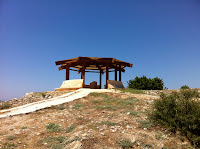 It has been quite some time since my Part I post about Korion, so here is Part II, long overdue. There is so much history behind this city and I know I will butcher it if I try to recount everything that was told to me, so this will largely be a picture blog. I'll explain as much as possible as I go along. Here is the amphitheater. It is currently outfitted for modern day concerts, plays, outdoor movies etc. This picture does not do the size and beauty of the theater justice, but it does show the amazing view of the Sea. The city of Kourion was largely a place for the wealthy to live, the theater, large baths, large square/market. It is speculated that the poor and the slaves lived outside of the city walls.
It has been quite some time since my Part I post about Korion, so here is Part II, long overdue. There is so much history behind this city and I know I will butcher it if I try to recount everything that was told to me, so this will largely be a picture blog. I'll explain as much as possible as I go along. Here is the amphitheater. It is currently outfitted for modern day concerts, plays, outdoor movies etc. This picture does not do the size and beauty of the theater justice, but it does show the amazing view of the Sea. The city of Kourion was largely a place for the wealthy to live, the theater, large baths, large square/market. It is speculated that the poor and the slaves lived outside of the city walls.
These mosaics were from the entrance to the baths and one of a bath itself (likely a cool bath as there is no heating floor underneath).
 This mosaic was from a dining area... note the beautiful 3-d effect in the lower right!
This mosaic was from a dining area... note the beautiful 3-d effect in the lower right!Below is one of the more famous stops.... a bench. Yes folks, it does look like a very important stop on the tour but no, it is just a viewing bench. Aren't you glad you hiked all the way up that hill?

 These are some ruins from an older building... if you look in the upper left of the picture you can see a slanted wall. This was likely the base of an older castle/temple/main structure and this would have been a fortifying wall. As it is now, it was incorporated into a variety of new buildings/rooms.
These are some ruins from an older building... if you look in the upper left of the picture you can see a slanted wall. This was likely the base of an older castle/temple/main structure and this would have been a fortifying wall. As it is now, it was incorporated into a variety of new buildings/rooms.
 There are several different styles of columns located throughout Kourion. I know nothing about the styles and how they reflect the time periods they were constructed except that they do. So there.
There are several different styles of columns located throughout Kourion. I know nothing about the styles and how they reflect the time periods they were constructed except that they do. So there.Here is a round hole. No, seriously, thats what it is! Likely it was a water feature of sorts. Very nice round hole though... these are the things us archaeologists appreciate.
Below is one of the largest and most impressive baths. If you remember the floor heating system I mentioned before, here you can see how thick that heating floor was.
The last photo is one of the few cobble mosaics.
This mosaic is from the house of the gladiators. There likely was no 'gladiating' on Cyprus, but often gladiators would spend time training away from the games. This could have been a training headquarters. It was located between the main city and the stadium (more on that in Part 3!).
 And last but not least, the church. Kourion was one of the last places on the island to convert to Christianity. It didn't convert until after a major earthquake in which the city lost its water supply, most of its population and was therefore easy to conquer.
And last but not least, the church. Kourion was one of the last places on the island to convert to Christianity. It didn't convert until after a major earthquake in which the city lost its water supply, most of its population and was therefore easy to conquer. Other notes from the day:
-It rained! Such a nice surprise.
- I wrote this blog sitting across from "The Edge" from U2. Pretty cool and props to Ryan for knowing who he was and recognizing him! (Guitarist for those of you who are U2 illiterate like myself).








No comments:
Post a Comment